Recently we’ve linked to a couple of scary posts, ie. The Methane Threat and Warning of mass extinction of species, including humans, within one decade, both at the Arctic News blog.
This is alarming to say the least.
The first thing I did was look up the Climate Plus archives tag for Methane.
My post of June 2015 Dealing with the methane time bomb is still worth reading.
I concluded then that the scientists appeared to be divided between methane alarmists and methane gradualists. There was great uncertainty about how much methane is stored, especially under the ocean, and whether it will be released rapidly enough to cause alarm. Methane is over 100 times more potent as a greenhouse gas than CO2 over the first five years, but then degrades to about 20 times more potent after 130 years. At that time atmospheric methane was 1900 parts per billion. CO2 accounts for about 80% of the greenhouse gas effect, with methane the second most significant greenhouse gas, according to NASA accounting for one-sixth of global warming.
Much of the alarm at that time had been generated by Natalia Shakhova of the University of Alaska at Fairbanks and her team, which had been studying the Arctic release of methane for 30 years. They published a paper in 2010 which calculated the effect of releasing 3% of the total store of methane in a 5-year period. They found that the extra methane would lead to additional warming of 1.3°C. They said it could happen, not that it would.
In December 2015 in Climate clippings 161 #6 I linked to a Scientific American article which reported that more methane was being emitted from the Arctic than previously thought. The principal finding was that the methane kept emitting, albeit at a lower rate, during the winter period. Half the methane emitted was released between September and May. Previously it had been assumed that methane was only released in the summer. Obviously, monitoring during the winter is fraught.
In December 2016 in Climate clippings 194 I reported on the release of the Global Methane Budget 2016. The news was not good.
- CSIRO researcher Dr Pep Canadell said it was the most comprehensive modelling to date and revealed a potentially dangerous climate wildcard.
“Methane emissions were stable for quite a few years at the end of the 2000s. But they’ve begun to grow much faster, in fact 10 times faster, since 2007,” said Dr Canadell, who is also the executive director of the Global Carbon Project.
Here is the relevant graph of growth since 2005:

The graph shows the possible trajectory for all the IPCC climate scenarios, with the black line showing actual observations.
However, the main concern in that report was not with the Arctic, rather with agriculture, and within that enteric fermentation from ruminants and manure.
Then earlier this month, in Climate clippings 201 #4, we were told of Methane Erupting From Arctic Ocean Seafloor.
Methane clathrates in the Arctic were erupting in concentrated plumes, which were missed by measuring stations and satellites. From the troposphere they spread to the equator, where the methane was wrongly assumed to come from tropical wetlands. This image showed a profile of the circulation systems.
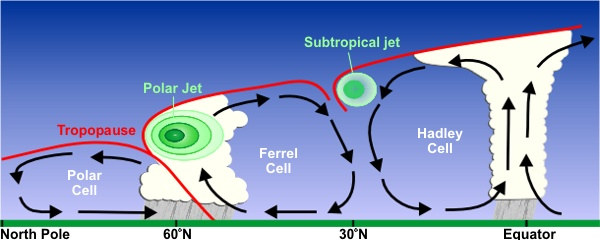
That article was from Arctic News. The article outlines what seems to be a theory posited by blog editor Sam Carana. No scientific paper is referred to and no mention is made of the fact that methane source can be distinguished by isotopic signatures, mentioned below.
At this point I’ll say that I’m a touch uneasy about the scientific solidity of what I read there. The blog authors listed seem to be well-qualified in science, but I’m not sure that any are actively researching the Arctic release of methane. From the blog, they are certainly methane alarmists.
For example, take this diagram which shows the mechanism whereby heat attacks the clathrates:
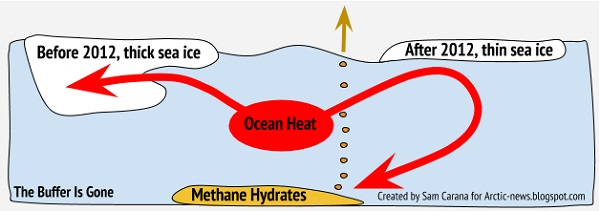
First of all, I can see no reason why the thickness of the ice cover should of itself make any difference to how heat in the water below behaves.
They may be on a better wicket when in this post from 2014 they assert that a warm tongue of water from the Gulf Stream penetrated the deeper water of the Arctic Ocean. That is the same Gulf Stream that we worry about slowing down or stopping.
The Gulf Stream is a surface current on its way north and may be bringing warmth to the shallower clathrates in the Arctic basin.
A less alarming article March 2016 article from NASA. Methane sourced from clathrates at that time constituted about one per cent of emissions. There is masses of the stuff down there, that much now seems to be agreed, but:
- most gas hydrate—about 99 percent—is sequestered in deep-water environments where temperatures are cold enough and the pressures are great enough for the deposits to remain stable. Most of these deep-water deposits lay buried beneath layers of sediment, so even if global warming continues for thousands of years, it would probably have little effect on them.
Just a small portion of gas hydrates (about 3.5 percent) occurs at depths where warming ocean waters may be causing the methane hydrate to break down, sending methane bubbling up. However, methane released underwater still rarely reaches the atmosphere directly. Microbes on the ocean floor and living within the water column usually consume it or convert it into carbon dioxide first.
(Emphasis added)As such some can then be absorbed into the water column on the way up.
Carolyn Ruppel, is or was chief of the U.S. Geological Survey’s gas hydrate program.
- Just 1 percent of methane hydrates are found at very shallow depths under Arctic permafrost, either on land or just offshore. On land, even the shallowest methane hydrates are still deeply buried by sediments so gas cannot escape easily. In shallow marine areas, methane hydrates could break down with warming, Ruppel notes, but deposits in this region represent such a small percentage of the overall methane hydrate stores that the climate impact would be minimal.
“We certainly will not see the catastrophic climate effect or runaway climate change from disintegrating gas hydrates that some have claimed,” said Ruppel.
More recently from NOAA in October 2016 we have a press release Study finds fossil fuel methane emissions greater than previously estimated.
The study led by scientists from NOAA and CIRES found that:
fossil fuel activities contribute between 132 million and 165 million tons of the 623 million tons of methane emitted by all sources every year. That’s about 20 to 25 percent of total global methane emissions, and 20 to 60 percent more than previous studies estimated.
They say that methane emissions have distinct isotopic signatures that distinguish whether a sample came from fossil fuel development and natural geologic sources, microbial activity, or biomass burning.
-
Isotopic analysis points to natural or human-caused microbial sources as the source of between 364 million to 419 million tons of methane per year, or 58 to 67 percent of methane released to the atmosphere each year, Schwietzke said. Total methane emissions from all sources increased by about 28 million tons per year between 2007 and 2013.
“We believe methane produced by microbial sources – cows, agriculture, landfills, wetlands, and fresh waters – are responsible for the increase, but we cannot yet pinpoint which are the primary drivers,” he said. “If the methane is mainly coming from cows or ag, then we could potentially do something about it. If it’s coming from decaying vegetation in wetlands or fresh waters, then a warming climate could be the culprit, which means that it could be part of a self-reinforcing feedback loop leading to more climate change. Those are big ifs, and we need to figure them out.”
Joining in the fun, with an alarmist post on 14 April just passed we have Julian Cribb on his blog with Early warning of a runaway climate.
Cribb is a science writer. His latest book Surviving the 21st Century: Humanity’s Ten Great Challenges and How We Can Overcome Them is one I’d like to read. I did a post on it last December. However, he is distinctly alarmist on methane and I wonder about his objectivity.
For example, he says “scientists report a sudden surge in global methane emissions in the last three years, 2014-16.” If you follow the link you get an article by M Saunois et al, The growing role of methane in anthropogenic climate change. From the abstract:
- New analysis suggests that the recent rapid rise in global methane concentrations is predominantly biogenic-most likely from agriculture-with smaller contributions from fossil fuel use and possibly wetlands.
He reports:
- Russian scientists have reported the discovery of thousands of potential ‘methane-bombs’ – frozen gas-filled mounds known as pingos – across Siberia, primed to explode as the ground thaws out.
The link takes you to an article from September 2015 which, while expressing concern, specifically says that it’s premature to talk about a global catastrophe. No mention is made of much of the methane being chewed by microbes and coming out as CO2, which I covered in my June 2015 post.
Then he says:
- Swedish scientists have observed the waters of the Arctic oceans ‘fizzing like soda water’ as the ocean currents warm, causing frozen seabed methane to turn back into gas and erupt.
The link is to a better post about new plumes of methane found in research led by the Swedes in a particular place just as they were wrapping up their research in August 2014. Peter Wadhams, an Arctic News author, is revealed as the one who did the calculations about a possible release of 3% of the total store of methane in a 5-year period mentioned further up.The short answer is that was dealt known and dealt with when I wrote the June 2015 post and is not now news.
Most naughty of Cribb, he lists a link for further reading without mentioning it which turns out to be an article Could Subsea Methane Hydrates Be a Warming “Tipping Point”? based on an interview with Carolyn D. Ruppel and John D. Kessler who had just written a paper The interaction of climate change and methane hydrates.
The paper says that there is some “dissociation” happening now on global upper continental slopes and on continental shelves that ring the Arctic Ocean, but there is no conclusive proof that any of the methane gas released makes it to the surface. The answer in the interview about methane hydrates being a global warming tipping point is an emphatic “no”.
That was published the day before Cribb’s blogpost.
Cribb does publish a useful graph, sourced from NOAA, showing the rise of methane emissions:
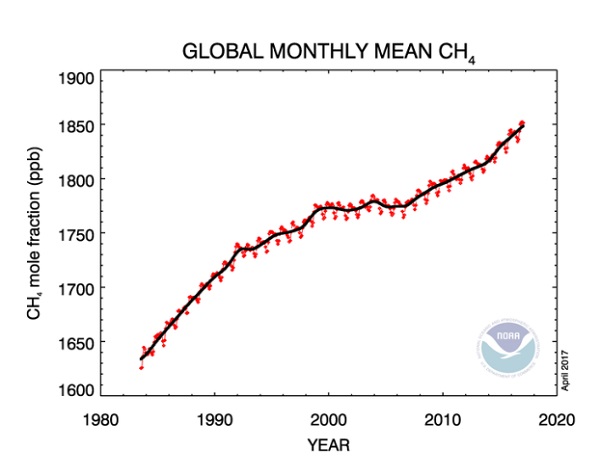
Uncertainties abound in how methane is monitored and no-one is sure just where the extra methane is coming from. However, methane coming from ocean clathrates and permafrost come from a very low base:
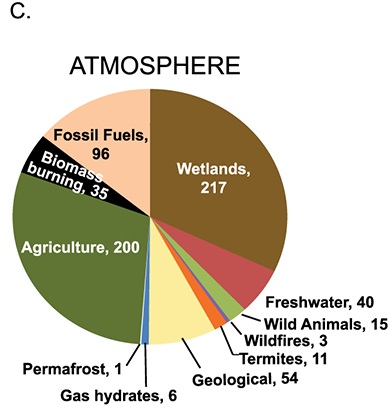
Sorry, I’ve lost the source, but it was from a recent paper. The numbers add up to 678 million tonnes, so it’s a recent number. Scientific critics of the Arctic methane catastrophe thesis worry that it distracts from dealing with sources of emissions that we can do something about. This graph, apparently from 2011 in the 2016 NASA article (you would think they has something more recent) shows past and future of anthropogenic methane emissions:
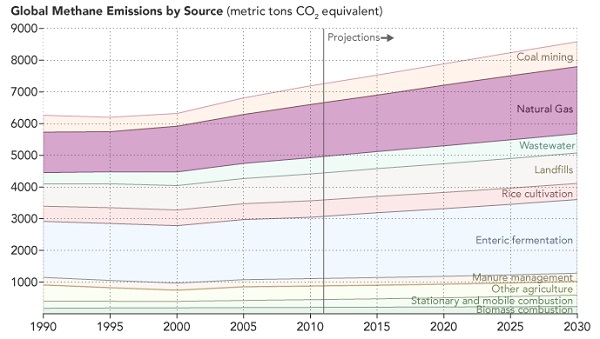
Enteric fermentation is mainly about sheep and cattle, and gas is mainly about fugitive emissions associated with the gas industry. Gas as a ‘clean’ energy source needs to come under more attention.
While there does not appear to be a warrant for suggesting that methane may render Homo sapiens extinct within a decade, the sad fact is that, as the World Meteorological Association’s State of the Climate 2016 (see Climate clippings 201 #2) shows, emissions in the form of CO2, methane and nitrous oxide are not only increasing relentlessly, but the rate of increase is rising:
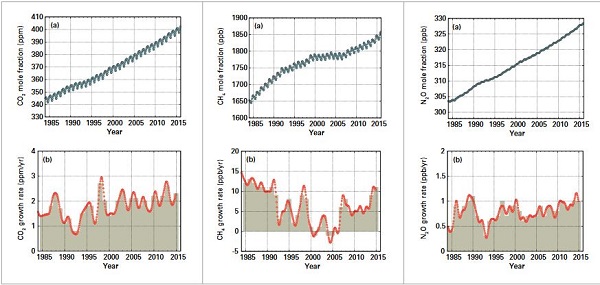
We are forcing the climate system harder than it was forced in the Paleocene–Eocene Thermal Maximum (PETM) 55 million years ago, or even in the Great Dying, the Permian-Triassic extinction event 252 million years ago. The circumstances were entirely different, the Earth was a different place, with a different starting temperature, the continents were differently distributed and the ocean currents would have been different. Nevertheless we should not be surprised if we run into an unexpected tipping point or two which could render warming irreversible in human time-scales. That’s what dangerous climate change is about.
Update: See also later post

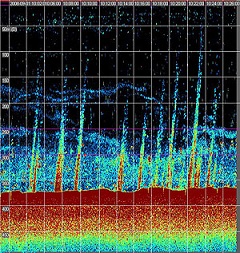
Sorry about the 2,000 word length, but the extinction of the human race is a serious subject, hence it has obsessed me in my screen time for a few days.
Good one Brian. Probably shouldn’t panic but it is worth asking what we could do to reduce CO2 equivalent apart from reducing consumption of fossil fuels and reducing fugitive methane associated with the extraction and use of these fossil fuels.
It is also important to recognize that agricultural methane is part of natural cycles with the methane being converted to CO2 which ends up being converted to the grass etc. that animals eat. It is also worth asking whether higher atmospheric methane will increase populations of bacteria that break down methane.
A few possibilities:
Shut down gassy coal mines or at least collect and use methane before mining.
Replace agricultural ruminants with things like kangaroos and chickens.
Inject methane consuming bacteria in places where this might do some good. (Rice paddies?)
BTWFor example, the GWP for methane over 100 years is 25[1] and for nitrous oxide 298. This means that emissions of 1 million metric tonnes of methane and nitrous oxide respectively is equivalent to emissions of 25 and 298 million metric tonnes of carbon dioxide.[2]
Good evaluation there, Brian.
I have to admit to being a methane alarmist who pales to in the flashing alarm of Sam Carana (but then I am not a cluster of scientists), and only because of various articles on studies that I have read over the years which have claimed an Arctic clathrate resource of some 13 trillion tonnes. Scary if true.
I have been watching this space for decades and the first indication other than Ian Axford and Shakova came from your observation of the Atlantic Cold Patch which I imagine is a pool of less saline melt water from Greenland mainly. It is mentioned in this article of some years back.
https://www.washingtonpost.com/news/energy-environment/wp/2016/06/30/the-mysterious-cold-blob-in-the-north-atlantic-is-starting-to-give-up-its-secrets/?utm_term=.32aab474caab
Interestingly the thermal image shows the cold patch bridging the Atlantic from continent to continent blocking the heat signature of the AMOC, but then there is evidence of a mysterious hot patch on the other side. I interpret this as being the AMOC being forced to flow under the lighter less saline cold spot and reemerging on the other side flowing more deeply in to the Arctic. The other potential factor in this is that due to the distance the warmer current must travel under the less dense meltwater it is not releasing its heat in the same way and so is not becoming more saline through evaporation, and so arrives in the Arctic both warm and less saline than it would had it travelled at the surface. Other factors that may influence what happens next will be to do with the basin into which the water is flowing.
This is a thorough examination of the properties of methane hydrates and various possible outcomes. Search the term pockmarks.
http://geosci.uchicago.edu/~archer/reprints/archer.2007.hydrate_stab.pdf
Its a case of only time will tell and watch this space very closely.
Brian, your effort to communicate complex science of existential importance is well received and appreciated. Thanks for the substantial overview of the situation and assuring conclusion. However, as John above points out it is worth asking pertinent questions, given the graph which shows the IPCC climate scenarios, and the veering off black line showing actual methane emissions observations. I guess given the character of the people in agriculture industry, they will be even harder to convince to adapt than those in mining and energy.
Ootz: There are also those that are hungry most of the time who may need convincing too.
Good review. I am working with TIR satellite data for the Arctic. See my papers in ResearchGate under my name. Three papers in a peer-reviewed journal have been published and one is under review. Main points are:
1) TIR satellite data are reliable for the Arctic Ocean under a condition of sufficiently warm surface. Year -round observations are possible.
2) Most of marine methane are emitted from November to January. It is explained by a winter-time temperature maximum in the bottom sea layer and unstable stratification in contrast to summer.
3) Locations of emissions follow the route of the North-Atlantic current: Norway, Svalbard, Novaya Zemlya. ESAS is an area with a minor, but detectable methane emission.
4) Total marine Arctic emission is estimated as 2/3 of that from the Arctic land to the North from 60 N.
5) Evolution of methane anomaly between 2010 and 2016 is treated in the last paper under review.
FINALLY. I am in the “Arctic News” list, but I am not an alarmist, rather I am a gradualist. Someone of other listed also may disagree with naming them “alarmist”. Be careful, please.
Leonid Yurganov, I apologise if my comment implied any specific people might be alarmists.
From my perspective alarmism is a relative and variable concept quantifiable in a proportional-integral-derivative feedback relationship where Atmospheric Green House Gasses are the power applied, Global Actions on Climate Change are the Kp,Ki,and Kd tuning parameters, 1.5C is the setpoint, and my level of Alarm is equal to u(t)^2. But that is just wide eyed observer me.
Brian,
This is an interesting and informative site which gives some degree of perspective…..
http://e360.yale.edu/features/as_arctic_ocean_ice_disappears_global_climate_impacts_intensify_wadhams
The header image goes a little way to visualising the change in the nature of the ice cover of the Arctic, from being a thick sheet form with great depth to becoming a seasonal ice patchwork over large areas. Still included within the “Arctic ice extent”, but nothing of its historic form.
My concerns are largely based on the “what we don’t know” factor which with polar research routinely delivers surprises such as the discovery of ice sheet rivers that transport melt water from the top of a sheet directly to under ice sheet lakes which can lubricate the junction between a sheet and the foundation it sits on to speed up the ice flow rate. We all remember this item
https://www.newscientist.com/article/dn2367-warming-speeds-ice-sheet-flow-in-weeks/
So what are the potential surprises regarding methane release from the Arctic Sea floor. For starters for me a surprise from the earlier linked article was that undersea landslides can trigger very large methane release events. Earlier Arctic News item looked at a fault line that cuts across the Arctic Sea floor as a triggering mechanism (though an active fault line should have only young methyl hydrate buildup in its near vacinity).
There is a lot more to learn. The alarming suggestion of extinctions should be no surprise as human activity on its own has setup the conditions for very large die off numbers with so many species on the verge all at the same time. It will not take much of a climate shift to finish these species off in the space of a few years. As for an “extinction” of humans, well that is truly alarmism, but a substantial die back is very much a probability, I believe.
First, thanks for the compliments about the post. I’m not scientist, and did no science beyond secondary school, and that a long time ago.
Leonid, thanks for your informed comment. My comments about Arctic News were first impressions. I wasn’t in fact aware of the site until BilB started linking to it recently.
On reflection, I’m uncomfortable with the gradualist/alarmist dichotomy. I think other positions are possible, especially if we consider what might happen in terms of centuries, rather than millennia or decades. Century-scale events are still abrupt from a geologic time perspective.
I need to finish this week’s Saturday salon post, and follow up BilB’s links before I comment further. Watched rugby league last night between the Broncos and the Rabbitohs. A stranger sequence of events and referee rulings you would never hope to see, which made the game into a lottery. Genuinely the difference was a few centimetres here and there.
I like the word “gradualism”. Generally, it is mostly natural. Similarly to “the presumption of innocence” there should be “presumption of graduality”. Nobody should prove graduality, but abruptness must be proven.
Food for thought JD
Thank you for your input Leonid, much appreciated to have somebody on board who is ‘hands on’ with the topic.
I guess with stakes that high and and not able to rule out a catastrophic outcome altogether is not really assuring at all. And thus, Brian’s comment about not comfortable with the gradual-alarmist dichotomy is on the mark. But first, Brian you may not ‘have done’ science as a career, though you have a sound grasp of it’s principles and across a many fields in science. More so, you are an meticulous researcher and analyst who has a gift to communicate. I am saying that to make a point as much as complementing Brian. To ‘do science’ is one thing, to put meaning to such science and being able to communicate in a efficiently that is another.
The reason it pays to be an agnostic re the gradual-alarmist methane scenarios, is the relationship between probability and magnitude of risk involved in the two scenarios and more so the meaning extracted by the various ‘interested’ parties in this planetary scale gamble we are taking. First, risk posed by methane emissions, given the actual emissions measured and logged, is according to the ‘done science’ of IPCC already unacceptable. So we are already with an elevated baseline and in that context framing the issue in “gradualism” vs “alarmism” is not conducive to provide sensible meaning to the subject. Second, what are the odds, or probabilities based on evidence for each of these two scenarios and have alternatives been considered. Third, as an extension from the odds, what about the magnitude of the eventual outcome, is time the only variable? The subject is really much more complex and intricate for this dichotomy to do it justice. Particularly to provide productive meaning in the public debate it is dangerous to frame the subject in this simple dichotomy, I would “warn” the adherents to such, or ‘captives’ of such. Some of you here on Brian’s blog who have participated on my false dichotomy practical experiment may relate to that 🙂
Ootz, thanks, I give it a shot, but don’t expect to always get things right.
The most visited post on this site is Deep origins: language, which attracts a steady trickle of visitors. Last time I read it I thought it had a structural flaw, and really should be rewritten.
Anyway, to Leonid, I agree with a lot of what Ootz said. I think we can look at the gradualism issue in relation to climate science generally, as well as in relation to methane out-gassing in particular. In the case of the latter the gradualists seem to be in the ascendancy.
Yet we don’t know how far warming would go over the next centuries and millennia if emissions were held to their present levels. The Potsdam report Turning down the heat, done for the World Bank :
That’s if 2°C is the right number. Also we may already have emitted enough to take us beyond 2°C in the long run.
The IPCC has done us a disservice, I think, in not taking sufficient notice of long-term feedbacks and in normalising the acceptance of 67% risk as a policy aim.
I think more attention should be paid to what Martin Weitzman identified as “low-probability, high-negative impact events” or fat-tailed uncertainty in relation to risk.
So I’m not sure that if we, say, limit emissions to present levels for the next century or two, whether tipping points will or will not be triggered in methane outgassing or tropical forest dieback in particular. Such tipping points could carry us forward to warming that threatens civilisation as we know it.
Those who say that we can double pre-industrial emissions, and stay safe, I mean one in a million safe, must be very certain that they are right. I don’t see that they can be.
All I can really say is:
-Humans have a better chance of surviving a crisis if there are fewer of us and it is easier for people to move in the event of deteriorating conditions in part of the world.
– There are technologies that will allow food to be produced despite a changing environment.
-Slowing change will give all forms of life a better chance of adapting or moving. So we need to get on with reducing emissions and greenhouse gas levels.
At the moment we seem to be doing none of these things.
Troubled times ahead, I think, John.
On gradualism in climate change generally, on the Cyclone Debbie thread I posted a comment showing images of how ocean heat predominates, and its increase has been relentless and one might say gradual, although that wasn’t my point at the time.
In response Roger Jones said, of course the interesting part is what happens after the heat goes into the ocean.
Of course Roger’s work has been to demonstrate that surface warming and climate as we experience it changes step-wise rather than in a linear trend-line. For a fuller explanation see his joint paper here.
One can’t help but be impressed. If we use multi-year moving averages or impose trendlines, we reveal the overall direction of change. However, if we want to understand what’s happening we need to investigate what causes the bumps and lumps along the way.
What is alarming, however, is when the whole system becomes unstable and moves rapidly. Google Younger Dryas, Heinrich event and Heinrich and Dansgaard–Oeschger Events.
Brian: Agree that there is a risk of lumps and bumps that affect particular areas. Also recognize that there are many instabilities in the system. Ex: More snow=more heat reflection=more snow and vice versa.
Most of what I said above applies equally to cooling or heating.
I’ve just learnt something I didn’t know from the US EPA site on evaluating the effect of greenhouse gases:
It’s a bit early in the morning for me, but the value appears to depend on the context of their communication.
An opinion piece in the NYT which expresses the concerns of the multitude.
https://www.nytimes.com/2017/04/21/opinion/the-planet-cant-stand-this-presidency.html
BilB, that’s Bill McKibben, who famously asked James Hansen what level of emissions in the atmosphere should we aim at for a safe climate.
Hansen thought about it for a few months, and then at a press conference at the American Geophysical Union meeting in December 2007 made his call – 350ppm in the first instance, then when we’ve got there, have another think.
So McKibben started 350.org and since then the world, including many climate scientists I fear, have failed to keep up.
I’ve put up a new post Climate change and the Arctic: we should worry.